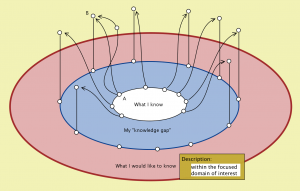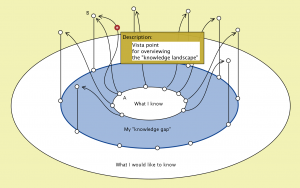This page is a sub-page of our page on Knowledge Mapping.
///////
Related KMR-pages:
In Swedish:
• NSDL (Nya Samarbetsformer i det Digitala Lärandelanskapet)
In English:
• New Collaborations within the Digital Learning Landscape (NSDL) – Next phase
///////
Other relevant sources of information:
• …
///////
Scenario
Let us describe the knowledge mapping process in steps, focusing on one individual that we may call Erik, who studies in high school and who is interested in space travel.
Step 1: From one of his teachers Erik learns that there are a number of cultural heritage institutions that offer knowledge mapping within their respective knowledge domains. During a visit to the Technical Museum – during its hosting of a special exhibit on space – Erik is assisted by a knowledge mapper from the museum to initiate a personal knowledge mapping process around space travel. In the first step the mapping is concentrated on describing Erik’s knowledge gaps within this knowledge domain. These knowledge gaps are documented in the overview tool Conzilla and the e-portfolio tool Confolio. The e-portfolio part of the documentation consists of (i) a folder with links to things that Erik already knows about space travel, and (ii) a folder with links to things that he would like to know about this subject. This process results in a knowledge-gap map for Erik within the knowledge domain of space travel
Step 2: Erik now brings his knowledge-gap map to school and asks the question: How can you help me to get to the place where I want to go from the place where I’m at with my knowledge of space travel? The school responds by helping Erik to create a knowledge development plan (knowledge roadmap) for acquiring the knowledge he would like to possess – as documented by his knowledge-gap map.
A knowledge development plan is a strategic plan that includes:
(i) how Erik best should be able to get from his current knowledge position A
to his desired knowledge position B,
(ii) what this might mean for Erik with regard to investment of time and “mental energy”,
(iii) what types of challenges and difficulties that could be expected on the trip from A to B – given Erik’s own personal circumstances and starting points.
Part (i) of Erik’s knowledge development plan contains descriptions of a number of possible knowledge trails that seem promising for him to “hike along” in order to get from A to B, and a brief description of why they seem promising and who that thinks so. These descriptions are later compared with Eric’s own experiences of hiking along some of these knowledge trails.
Step 3: The school supports Erik in realizing (implementing) suitable parts of his knowledge development plan by hiking along some of the most promising knowledge trails within the surrounding knowledge landscape. Erik regularly compiles travel reports about his impressions and insights from these knowledge hikes.
Step 4: In collaboration with Wikimedia these reports are then aggregated and converted into learning objects in the form of (rich-media based) stories of Erik’s own learning experieces in attempting to move from A to B in the knowledge landscape in accordance with his knowledge development plan. These learning experiences may cause Erik to update his knowledge development plan with help from a knowledge mapper at school.
Step 5: The resulting learning objects are passed to a knowledge broker in the cultural heritage institution which started the knowledge mapping process. In collaboration with a knowledge broker at Erik´s school, s/he then tags them and uploads them within a knowledge manifold (knowledge network). Erik can then link to them from the appropriate folders in his own e-portfolio.
In this manner, schools and cultural institutions gradually create a shared knowledge network that relates knowledge offerings to knowledge gaps, knowledge development plans, and learning experiences while trying to follow these plans – documented in a way so that others may benefit from these experiences.
This reflects another emerging library role, namely the role of knowledge broker that can connect different knowledge maps (called knowledge patches in Naeve 2001a) and provide strategic advice to schools on how best to complement each other’s knowledge development processes and build a common knowledge network (Naeve, 2005 2010) that documents students’ and teachers’ own learning experiences of the knowledge building activities that they have been part of within the community. Over time, this network can function as an experience network (experienced CRM) – a kind of advisory network offering advice for future knowledge hikers in order to help them find knowledge paths that suit their own individual starting points, aims and learning styles.
This scenario has reached the boundaries of what it will be possible to work with within the NSDL-2 project. However, an important point is that we are creating a knowledge architecture that allows us to better integrate school activities with the surrounding community and create new forms of collaborative opportunities. This is of strategic importance for job creation.
Turning an (un)employment agency into an opportunistic collaboration agency:
A knowledge network connected to an opportunity network can provide dynamic matching services for fostering and encouraging opportunistic collaboration.
Knowledge maps create possibilities for new forms of matching services between needs and skills – matching services that can create new opportunities for collaboration. Naeve (2010) describes how to transform a traditional employment agency into an “Opportunistic Collaboration Agency” that can match skills with opportunities and provide suggestions for possible collaborations.
Each collaboration seeker who comes to this OCA inspects the (col)labor(ation) opportunities that are listed in the agency’s support system. These possibilities correspond to different needs which have been expressed
(i) by various potential employers, but also
(ii) by the collaboration seekers themselves.
Each collaboration seeker has the option to add a “bid for delivery” against one (or more) of these needs, and specify what help s/he needs in order to deliver on this bid (= promise). This will create new needs in the system – needs that can in turn be inspected and “bid for” by other collaboration seekers. The support system then functions as a kind of “super-doodle” that attempts to detect chains – or preferably loops – of needs that can be met in collaboration between the involved bidders and then informs them about this opportunity.
If the “bidders” decide to collaborate to satisfy this chain or loop of needs, then the system provides information on the various administrative measures that must be taken in order to formalize the collaboration. In this way, collaboration seekers can create their own projects in an opportunistic and dynamic way. Hence the OCA becomes a meeting place where collaborative job opportunities can be created by the collaboration seekers themselves. See (Naeve, 2010) for more detailed information on this subject.
//////

